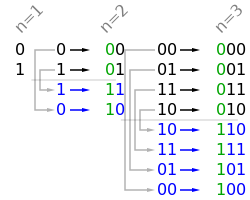Constructing an n-bit Gray code[edit]
The binary-reflected Gray code list for n bits can be generated recursively from the list for n−1 bits by reflecting the list (i.e. listing the entries in reverse order), concatenating the original list with the reversed list, prefixing the entries in the original list with a binary 0, and then prefixing the entries in the reflected list with a binary 1.[6] For example, generating the n = 3 list from the n = 2 list:
| 2-bit list: | 00, 01, 11, 10 | |
| Reflected: | 10, 11, 01, 00 | |
| Prefix old entries with 0: | 000, 001, 011, 010, | |
| Prefix new entries with 1: | 110, 111, 101, 100 | |
| Concatenated: | 000, 001, 011, 010, | 110, 111, 101, 100 |
The one-bit Gray code is G1 = (0, 1). This can be thought of as built recursively as above from a zero-bit Gray code G0 = { Λ } consisting of a single entry of zero length. This iterative process of generating Gn+1from Gn makes the following properties of the standard reflecting code clear:
- Gn is a permutation of the numbers 0, ..., 2n−1. (Each number appears exactly once in the list.)
- Gn is embedded as the first half of Gn+1.
- Therefore the coding is stable, in the sense that once a binary number appears in Gn it appears in the same position in all longer lists; so it makes sense to talk about the reflective Gray code value of a number: G(m) = the m-th reflecting Gray code, counting from 0.
- Each entry in Gn differs by only one bit from the previous entry. (The Hamming distance is 1.)
- The last entry in Gn differs by only one bit from the first entry. (The code is cyclic.)


No comments:
Post a Comment